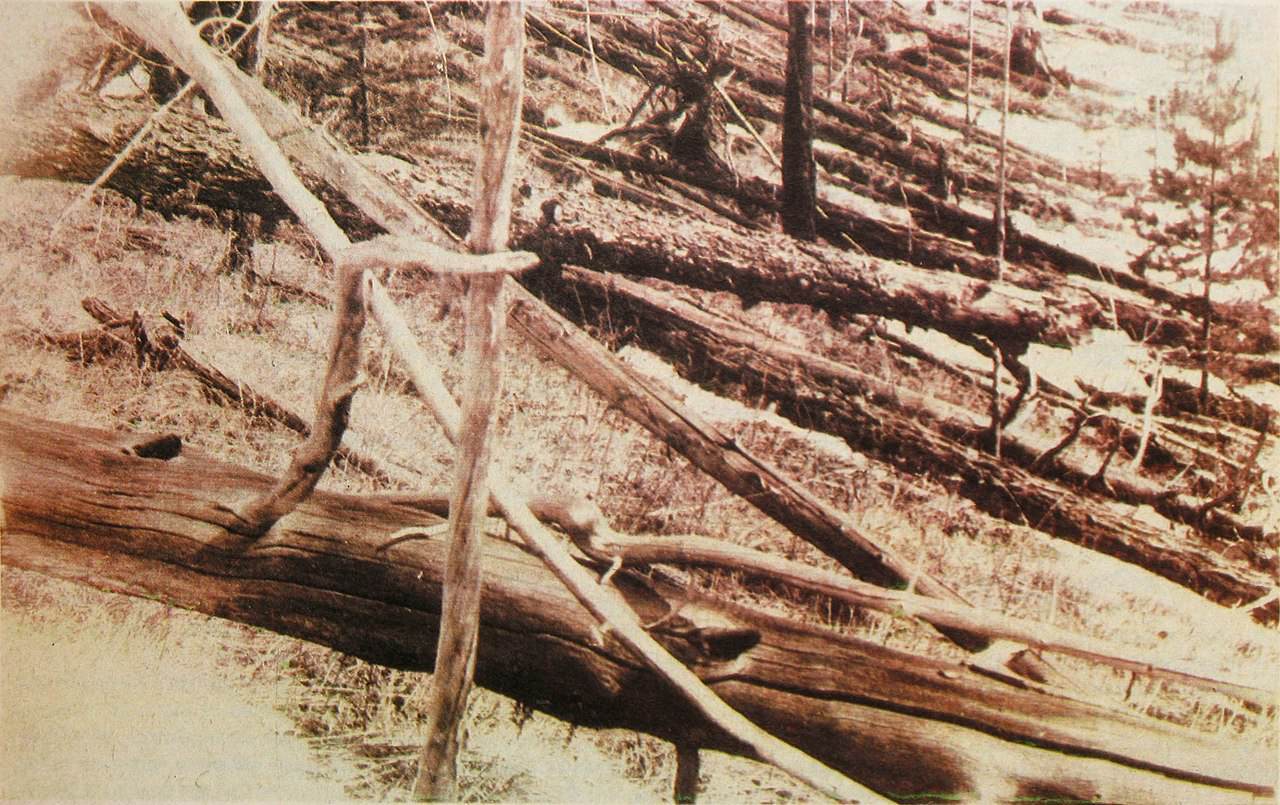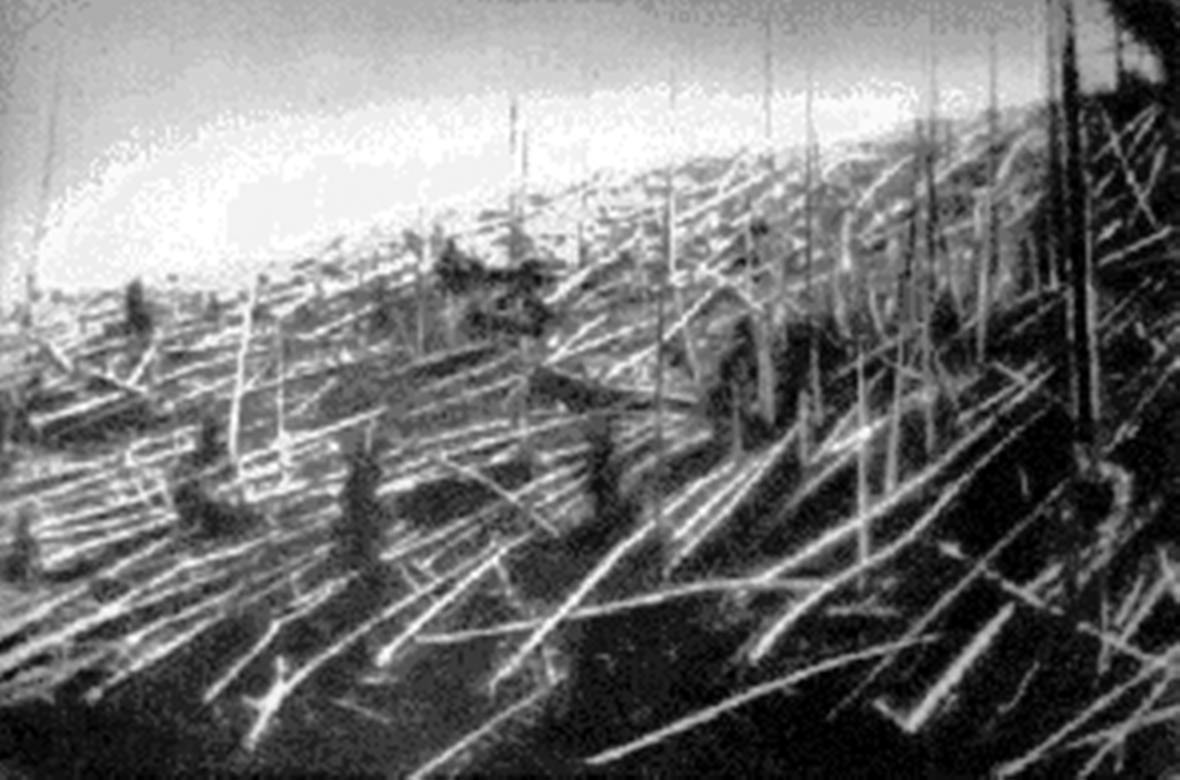In 1908, a mysterious phenomenon known as the Tunguska Event caused the sky to burn and more than 80 million trees to fall. The most consistent explanation assures that it was a meteorite; however, the absence of a crater in the impact zone has sparked all kinds of theories.
The mystery of the Tunguska Event

Each year, the Earth is bombarded by approximately 16 tons of meteorites that fall into the atmosphere. Most barely reach a dozen grams in mass and are so small that they go unnoticed. Some more can cause a glow in the night sky that disappears in a matter of seconds, but… what about meteorites with the potential to wipe out a region of the world?
Although the most recent impact of an asteroid capable of causing a worldwide cataclysm dates back 65 million years, on the morning of June 30, 1908, a devastating explosion known as the Tunguska event rocked Siberia with the force of 300 atomic bombs.
Around seven in the morning, a huge fireball shot through the sky over the central Siberian plateau, an inhospitable area where coniferous forests give way to tundra and human settlements are scarce.
In a matter of seconds, scorching heat set the sky ablaze and a deafening explosion engulfed more than 80 million trees in an area of 2,100 square kilometers of forest.
The event caused shock waves that, according to NASA, were recorded by barometers throughout Europe and hit people more than 40 miles away. For the next two nights, the night sky remained illuminated in Asia and some regions of Europe. However, due to the difficulty of accessing the area and the absence of nearby towns, no expedition approached the site in the next thirteen years.
It was not until 1921 that Leonid Kulik, a scientist at the St. Petersburg Museum of Mineralogy and meteorite expert, made the first attempt to get closer to the impact site; however, the inhospitable nature of the region led to the failure of the expedition.

In 1927, Kulik led another expedition that finally reached the thousands of burned kilometers and to his surprise, the event did not leave any impact crater, only an area of 4 kilometers in diameter where the trees were still standing, but without branches, no bark. Around it, thousands of more downed trees marked the epicenter for miles, but incredibly, there was no evidence of a crater or meteorite debris in the area.
“The sky was split in two and a fire appeared on high”
Despite the confusion, Kulik’s effort managed to break the hermeticism of the settlers, who provided the first testimonies of the Tunguska Event.
The account of S. Semenov, an eyewitness who was 60 kilometers from the impact and was interviewed by Kulik, is perhaps the most famous and detailed of the explosion:
“At breakfast time I was sitting next to the post house in Vanavara (…) suddenly, I saw that directly to the north, on the Tunguska road from Onkoul, the sky split in two and a fire appeared overhead and wide above the forest The split in the sky grew larger and the entire north side was covered in fire.
At that moment I got so hot that I couldn’t bear it, like my shirt was on fire; from the north side, where the fire was, came a strong heat. I wanted to rip my shirt off and throw it down, but then the sky closed and a loud bang rang out and I was thrown a few feet away.
I lost consciousness for a moment, but then my wife ran out and took me home (…) When the sky opened, the hot wind ran between the houses, like from canyons, which left traces on the ground like roads, and some crops were damaged. Later we saw that many windows were broken and in the barn, a part of the iron lock broke.”
During the following decade, there were three more expeditions to the area. Kulik found several dozens of little “pothole” bogs, each 10 to 50 meters in diameter, that he thought might be meteoric craters.
After a laborious exercise in draining one of these bogs―the so-called “Suslov’s crater”, 32 meters in diameter―he found an old tree stump on the bottom, ruling out the possibility that it was a meteoric crater. Kulik could never determine the actual cause of Tunguska Event.
Explanations to the Tunguska Event
NASA considers the Tunguska Event to be the only record of a large meteoroid entering Earth in modern times. However, for more than a century, explanations for the non-existence of a crater or meteorite material at the site of the alleged impact have inspired hundreds of scientific papers and theories of exactly what happened in Tunguska.
The version most accepted today assures that on the morning of June 30, 1908, a space rock approximately 37 meters wide penetrated the Earth’s atmosphere at a speed of 53 thousand kilometers per hour, enough to reach a temperature of 24 thousand degrees celsius.
This explanation ensures that the fireball that illuminated the sky did not make contact with the earth’s surface, but exploded eight kilometers high, causing the shock wave that explains the disaster and the millions of fallen trees in the Tunguska area.
And although other intriguing theories without strong scientific support consider that the Tunguska event could have been the result of an antimatter explosion or the formation of a mini black hole, a new hypothesis formulated in 2020 points to stronger explanations:
Dapre yon etid pibliye nan la Royal Astwonomi Sosyete, the Tunguska event was indeed triggered by a meteorite; however, it was a rock formed by iron that reached 200 meters wide and brushed the Earth at a minimum distance of 10 kilometers before continuing its orbit, leaving a shock wave of such magnitude in its wake that it caused the sky would burn and the millions of trees would be felled.
Tunguska explosion caused by aliens?
In 2009, a Russian scientist claims that aliens downed the Tunguska meteorite 101 years ago to protect our planet from devastation. Yuri Lavbin said he had found unusual quartz crystals at the site of the massive Siberian explosion. Ten crystals had holes in them, placed so the stones can be united in a chain, and other have drawings on them.
“We don’t have any technologies that can print such kind of drawings on crystals,” said Lavbin. “We also found ferrum silicate that can not be produced anywhere, except in space.”
This wasn’t the first time a UFO has been claimed to associated with the Tunguska event by scientists. In 2004, members of the scientific expedition of the Siberian state foundation “Tunguska Space Phenomenon” claimed that they had managed to uncover blocks of an extraterrestrial technical device, which crashed down on Earth on June 30th, 1908.
The expedition, organized by the Siberian Public State Foundation “Tunguska Space Phenomenon” completed its work on the scene of Tunguska meteorite fall on August 9, 2004. Expedition to the region was guided by the space photos, the researchers scanned a wider territory in the vicinity of the Poligusa village for parts of the space object that crashed into Earth in 1908.
In addition, the expedition members found the so-called “deer”―the stone, which Tunguska eyewitnesses repeatedly mentioned in their stories. The explorers delivered a 50-kilogram piece of the stone to the city of Krasnoyarsk to be studied and analyzed. No subsequent reports or analysis could be located during an internet search.
konklizyon
Despite countless investigations, the so-called Tunguska Event remains one of the 20th century’s greatest enigmas―seized upon by mystics, UFO enthusiasts and scientists as evidence of angry gods, extraterrestrial life or the impending threat of a cosmic collision.




